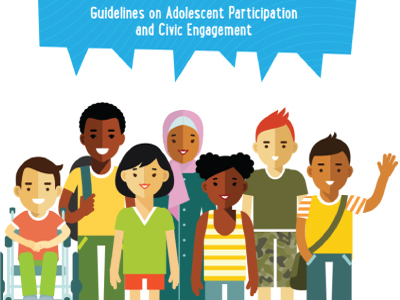About the Course
This course contributes to building your capacity to promote, design and implement at-scale programming for meaningful adolescent participation and civic engagement. The course provides you with learning on the rational and conceptual underpinning of adolescent participation, the five key strategies and their interventions, as well as organizational processes required to support it. The course is based on UNICEF’s Guidelines for Adolescent Participation and Civic Engagement.
Learning Objectives
The overarching learning objective for this resource is to build the learners knowledge and skill set on programmatic approaches to support meaningful adolescent participation and civic engagement.
Upon completion of the course, learners will be able to:
- Describe the rationale and conceptual underpinning for adolescent participation and civic engagement.
- Understand and apply the five strategies and their key interventions for adolescent participation and civic engagement.
- Explain the organisational processes and commitments required to support meaningful adolescent participation and civic engagement.
- Summarize how adolescent participation can be integrated in each stage of the programme cycle and in UNICEF programme planning processes.
Audience
- UNICEF staff (country offices, regional offices and HQ);
- UNICEF National Committee staff, consultants, interns, volunteers, goodwill ambassadors and National Committee board members;
- UNICEF partners incl. government, civil society, private sector;
- Academic institutions and students.
Length
It should take you about 140 minutes to complete this self-paced course (100 minutes for Part 1 and 40 minutes for Part 2), but if you wish to look into the optional Further Reading provided, it will take longer.
Methodology
This course is composed of Part 1 that contains six short self-paced modules and a quiz testing your newly acquired knowledge, and of Part 2 that contains six fictive scenarios of which you must complete three to earn the certificate.
Part 1 introduces the key content and messages from UNICEF’s Guidelines for Adolescent Participation and Civic Engagement and uses illustrative photos and interactive sections and icons.
You will watch two animated videos, one on how to contextualize adolescents programming into the programme cycle and the second on how to integrate adolescent participation into a fictive country context and programme. The videos are available with English audio and subtitles in Arabic, English, French and Spanish.
Structure
The course is composed of Part 1 with five modules and one optional further reading:
- Introduction to key concepts
- Equitable and meaningful adolescent participation
- Strategies and key interventions
- Further reading (not mandatory)
- Organisational commitment
- Quiz
And Part 2 with six scenarios (of which the first two and a third to be selected by the learner are mandatory):
- Adolescent participation in school councils (mandatory)
- Adolescent peacebuilders (mandatory)
- Adolescent-friendly local governance
- Adolescent-led initiatives to prevent HIV
- Adolescent participation in Disaster Risk Reduction
- U-Reporters influencing policies affecting their protection, health and education
